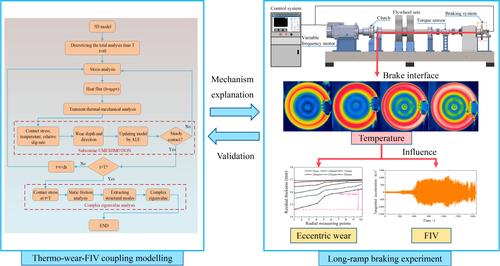Friction ( IF 6.3 ) Pub Date : 2025-6-3 , DOI: 10.26599/frict.2025.9441130
Wei Chen, Qixiang Zhang, Jiliang Mo, Zhicheng He, Xiaocui Wang, Song Zhu, Chunguang Zhao

|
A dragging friction experiment is conducted on a scaled brake dynamometer to simulate long-ramp braking conditions of high-speed train. Heavy thermal load is generated due to the long-time friction process, resulting in a high interfacial temperature of more than 480 ℃. The friction heat will be concentrated in the sliding region of the disc surface, where significant temperature gradient is formed. Eccentric wear phenomenon is identified in the radial direction of the block surface. This is different from the cases of ordinary braking conditions which produce relative low temperature, ordinary parking braking, for example, eccentric wear is found in the friction direction. Meanwhile, the friction-induced vibration (FIV) is found to closely correlate with the interfacial temperature, the vibration amplitude increases with the increase of the temperature, while the main frequency of FIV decreases as the temperature gets large. For a further exploration, a novel fully coupled thermomechanical-wear-FIV numerical method is proposed to simulate the temperature, wear and FIV evolution of the brake process. It indicates the numerical model can well reproduce the tribology behavior of the brake system, and the underlying mechanism of the eccentric wear phenomenon is explained. This numerical method can be used as an auxiliary tool to design or optimize the brake system in engineering.
中文翻译:

高速列车在长匝道制动条件下制动界面摩擦学行为的实验和数值研究
在缩放制动测功机上进行了拖动摩擦实验,模拟了高速列车的长匝道制动条件。由于长时间的摩擦过程,会产生沉重的热负荷,导致界面温度超过 480 °C。摩擦热将集中在圆盘表面的滑动区域,在那里形成显着的温度梯度。在块表面的径向上识别出偏心磨损现象。这与产生相对低温的普通制动条件不同,普通的停车制动,例如在摩擦方向上发现偏心磨损。同时,发现摩擦振动 (FIV) 与界面温度密切相关,振动幅值随温度的升高而增大,而 FIV 的主频率随温度的升高而降低。为了进一步探索,提出了一种新的全耦合热机械磨损 FIV 数值方法来模拟制动过程的温度、磨损和 FIV 演变。这表明数值模型能够很好地再现制动系统的摩擦学行为,并解释了偏心磨损现象的底层机制。这种数值方法可以用作工程中设计或优化制动系统的辅助工具。


















































 京公网安备 11010802027423号
京公网安备 11010802027423号